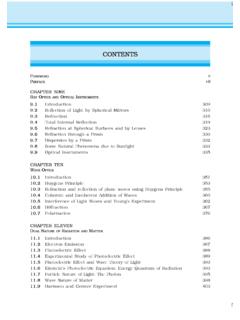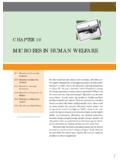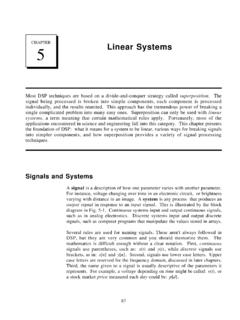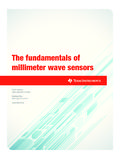Transcription of Chapter Fifteen COMMUNICATION SYSTEMS
1 INTRODUCTIONC ommunication is the act of transmission of information. Every livingcreature in the world experiences the need to impart or receive informationalmost continuously with others in the surrounding world. Forcommunication to be successful, it is essential that the sender and thereceiver understand a common language. Man has constantly madeendeavors to improve the quality of COMMUNICATION with other humanbeings. Languages and methods used in COMMUNICATION have keptevolving from prehistoric to modern times, to meet the growing demandsin terms of speed and complexity of information.
2 It would be worthwhileto look at the major milestones in events that promoted developments incommunications, as presented in Table COMMUNICATION has its roots in the 19th and 20th century inthe work of scientists like Bose, Morse, G. Marconi and AlexanderGraham Bell. The pace of development seems to have increaseddramatically after the first half of the 20th century. We can hope to seemany more accomplishments in the coming decades. The aim of thischapter is to introduce the concepts of COMMUNICATION , namely the modeof COMMUNICATION , the need for modulation, production and deductionof amplitude ELEMENTS OF A COMMUNICATION SYSTEMC ommunication pervades all stages of life of all living creatures.
3 Irrespectiveof its nature, every COMMUNICATION system has three essential elements- Chapter FifteenCOMMUNICATIONSYSTEMSP hysics514 Around1565 reporting of the delivery ofa child by queen using drumbeats from a distant place toKing of telegraph bySamuel Morse and SirCharles WheatstoneTelephone invented byAlexander Graham Bell andAntonio MeucciJagadis Chandra Bose andGuglielmo Marconidemonstrated broadcast(JohnLogi Baird)First radio FAX transmittedacross continent.(AlexanderBain)ARPANET - the first internetcame into existence( )Fiber optics developed at BellLaboratoriesTim Berners-Lee invented theWorld Wide is believed that minister Birbalexperimented with the arrangement todecide the number of drummers postedbetween the place where the queenstayed and the place where the resulted in tremendous growth ofmessages through post offices andreduced physical travel of the most widely used means ofcommunication in the history meant a giant leap from an era ofcommunication using wires tocommunicating without using wires.
4 (wireless)First television broadcast by BBCThe idea of FAX transmission waspatented by Alexander Bain in was a project undertaken bythe defence department. It allowedfile transfer from one computer toanother connected to the optical SYSTEMS are superior andmore economical compared totraditional COMMUNICATION may be regarded as the mammothencyclopedia of knowledge accessible toeveryone round the clock throughout SOME MAJOR MILESTONES IN THE HISTORY OF COMMUNICATIONC ommunication System515transmitter, medium/channel and receiver. The block diagram shown inFig. depicts the general form of a COMMUNICATION Block diagram of a generalised COMMUNICATION a COMMUNICATION system , the transmitter is located at one place,the receiver is located at some other place (far or near) separate from thetransmitter and the channel is the physical medium that connects upon the type of COMMUNICATION system , a channel may be inthe form of wires or cables connecting the transmitter and the receiver orit may be wireless.
5 The purpose of the transmitter is to convert the messagesignal produced by the source of information into a form suitable fortransmission through the channel. If the output of the information sourceis a non-electrical signal like a voice signal, a transducer converts it toelectrical form before giving it as an input to the transmitter. When atransmitted signal propagates along the channel it may get distorted dueto channel imperfection. Moreover, noise adds to the transmitted signaland the receiver receives a corrupted version of the transmitted receiver has the task of operating on the received signal. It reconstructsa recognisable form of the original message signal for delivering it to theuser of are two basic modes of COMMUNICATION : point-to-point point-to-point COMMUNICATION mode, COMMUNICATION takes placeover a link between a single transmitter and a receiver.
6 Telephony is anexample of such a mode of COMMUNICATION . In contrast, in the broadcastmode, there are a large number of receivers corresponding to a singletransmitter. Radio and television are examples of broadcast mode BASIC TERMINOLOGY USED IN ELECTRONICCOMMUNICATION SYSTEMSBy now, we have become familiar with some terms like information source,transmitter, receiver, channel, noise, etc. It would be easy to understandthe principles underlying any COMMUNICATION , if we get ourselvesacquainted with the following basic (i)Transducer: Any device that converts one form ofenergy into another can be termed as a electronic COMMUNICATION SYSTEMS , we usuallycome across devices that have either their inputsor outputs in the electrical form.
7 An electricaltransducer may be defined as a device that convertssome physical variable (pressure, displacement,force, temperature, etc) into correspondingvariations in the electrical signal at its output.(ii)Signal: Information converted in electrical formand suitable for transmission is called a can be either analog or digital. Analogsignals are continuous variations of voltage orcurrent. They are essentially single-valuedfunctions of time. Sine wave is a fundamentalanalog signal. All other analog signals can be fullyunderstood in terms of their sine wave and picture signals in TV are analog innature.
8 Digital signals are those which can takeonly discrete stepwise values. Binary system thatis extensively used in digital electronics employsjust two levels of a signal. 0 corresponds to a lowlevel and 1 corresponds to a high level of voltage/current. There are several coding schemes usefulfor digital COMMUNICATION . They employ suitablecombinations of number SYSTEMS such as thebinary coded decimal (BCD)*. American StandardCode for Information Interchange (ASCII)** is auniversally popular digital code to representnumbers, letters and certain characters.(iii)Noise: Noise refers to the unwanted signals thattend to disturb the transmission and processingof message signals in a COMMUNICATION source generating the noise may be locatedinside or outside the system .
9 (iv)Transmitter: A transmitter processes the incomingmessage signal so as to make it suitable fortransmission through a channel and subsequentreception.(v)Receiver: A receiver extracts the desired messagesignals from the received signals at the channeloutput.(vi)Attenuation: The loss of strength of a signal whilepropagating through a medium is known asattenuation.*In BCD, a digit is usually represented by four binary (0 or 1) bits. For examplethe numbers 0, 1, 2, 3, 4 in the decimal system are written as 0000, 0001, 0010,0011 and 0100. 1000 would represent eight.** It is a character encoding in terms of numbers based on English alphabet sincethe computer can only understand CHANDRA BOSE (1858 1937)Jagadis Chandra Bose(1858 1937) Hedeveloped an apparatusfor generating ultrashortelectro-magnetic wavesand studied their quasi-optical properties.
10 Hewas said to be the first toemploy a semiconductorlike galena as a self-recovering detector ofelectromagnetic published threepapers in the Britishmagazine, TheElectrician of 27 His invention waspublished in the Proceedings of The RoyalSociety on 27 April 1899over two years beforeMarconi s first wirelesscommunication on 13 December 1901. Bosealso invented highlysensitive instruments forthe detection of minuteresponses by livingorganisms to externalstimulii and establishedparallelism betweenanimal and System517(vii)Amplification: It is the process of increasing the amplitude (andconsequently the strength) of a signal using an electronic circuitcalled the amplifier (reference Chapter 14).















